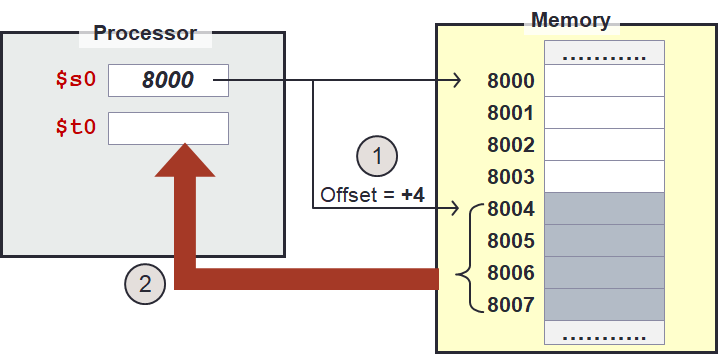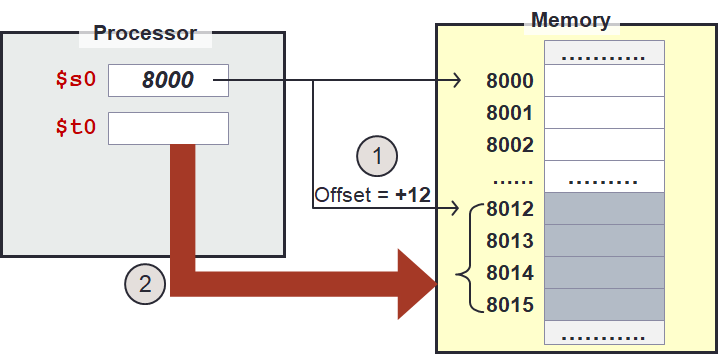Memory
MIPS is a load-store register architecture1. Which means, it divides instructions into two categories: memory access and ALU operations. The arithmetic and logical operations are part of the ALU operations. Incidentally, ALU is called the arithmetic and logic unit.
MIPS has 32 registers, each are 32-bit long (or 4-byte long). Each word contains 32 bits (or 4 bytes). Not surprisingly, memory addresses are also 32-bit long.
So what is the significant of this magic number 32? It means that each memory address can fit into a register nicely. However, note that MIPS uses byte addresses. So, data in each memory address holds a single byte (i.e., 8 bits). Which means, consecutive words differ by 4 in their addresses.
Word Alignment
Consecutive words differ by 4 in their address.
Memory Instruction
Only load and store instructions can access data in memory.
However, there are several variants of the instructions.
Word Addressing
Word Addressing
| MIPS | |
|---|---|
1 | |
| MipC | |
|---|---|
1 | |
Transfer a word from memory to register.
The address is computed as $rs + offset where offset is a 16-bit 2s complement number.
| MIPS | |
|---|---|
1 | |
| MipC | |
|---|---|
1 | |
Transfer a word from register to memory.
The address is computed as $rs + offset where offset is a 16-bit 2s complement number.
In both instructions, the address is compute the same way: $rs + offset.
Here, the register $rs holds the base address of the memory.
Typically it will match with an array in the high-level program.
Note that both instructions throws an error when the result $rs + offset is not word aligned (i.e., not multiple of 4 in the case of MIPS).
Visualisation
| MIPS | |
|---|---|
1 | |
| MipC | |
|---|---|
1 | |

Steps:
- Memory address =
$s0 + 4=8000 + 4=8004. - Memory word at
Mem[8004]is loaded into$t0.- Remember, we abstract memory as a single-dimension array.
| MIPS | |
|---|---|
1 | |
| MipC | |
|---|---|
1 | |

Steps:
- Memory address =
$s0 + 12=8000 + 12=8012. - Content of
$t0is stored into word atMem[8012].- Remember, we abstract memory as a single-dimension array.
Byte Addressing
Byte Addressing
| MIPS | |
|---|---|
1 | |
Transfer a byte from memory to register.
The address is computed as $rs + offset where offset is a 16-bit 2s complement number.
| MIPS | |
|---|---|
1 | |
Transfer a byte from register to memory.
The address is computed as $rs + offset where offset is a 16-bit 2s complement number.
Unlike lw and sw, the address need not be word aligned (i.e., not multiple of 4).
As such, the value can be any non-negative number between 0 and 232M-1.
Typically, these operations are used for string (i.e., array of char which is 1 byte long).
Which Byte?
There are 4 bytes in a register. In the case of load, we simply set the upper 3 bytes to all 0s. But which byte is going to be stored[^2]? In this case, the lower 1 byte is going to be stored. To put it in C-like syntax:
| Stored Byte | |
|---|---|
1 | |
Other Addressing
Other Addressing
| Load | |
|---|---|
1 | |
| Store | |
|---|---|
1 | |
| Load | |
|---|---|
1 | |
| Store | |
|---|---|
1 | |
| Load | |
|---|---|
1 | |
| Store | |
|---|---|
1 | |
Out of Scope
These other types of addressing are out of scope for our module. You are not allowed to use them for assignments and/or other assessments.
Unaligned Addressing
Unaligned Addressing
| MIPS | |
|---|---|
1 | |
| MipC | |
|---|---|
1 | |
Transfer a word from memory to register.
The address is computed as $rs + offset where offset is a 16-bit 2s complement number.
| MIPS | |
|---|---|
1 | |
| MipC | |
|---|---|
1 | |
Transfer a word from register to memory.
The address is computed as $rs + offset where offset is a 16-bit 2s complement number.
MIPS disallows loading/storing unaligned word using lw/sw.
These two above are pseudo-instructions to load/store unaligned words.
They can naively be translated into multiple real instructions with additional temporary registers.
Naive Translation
lw $s0, 3($s1)
| Unaligned Load Word | |
|---|---|
1 2 3 4 5 6 7 8 9 10 11 12 13 | |
sw $s0, 3($s1)
| Unaligned Load Word | |
|---|---|
1 2 3 4 5 6 7 8 9 10 11 | |
Examples
As this is one of the more important concepts in MIPS, we will dedicate a section for examples. You are advised to try the example on your own first before looking at the answer.
Array Operations
Assume that each array element occupies a word or 4 bytes (e.g., an integer array int A[N];).
| Array Operations (in C) | |
|---|---|
1 | |
| Variable | Register |
|---|---|
h |
$s2 |
A |
$s3 |
Note that for A, it is the base address of the first element since it is an array (i.e., &A[0]).
We use a single temporary register $t0.
| Array Operations (in MipC) | |
|---|---|
1 2 3 | |
| Array Operations (in MIPS) | |
|---|---|
1 2 3 | |
Note that arithemetic operads (e.g., add) are for registers, not memory!
Swap Elements
| Swap Elements (in C) | |
|---|---|
1 2 3 4 5 6 | |
| Variable | Register |
|---|---|
&v[0] |
$a0 ($4) |
k |
$a1 ($5) |
temp |
$t7 ($15) |
Note that you do not have to care about the function call (i.e., jump to the current instruction and jump back to the caller).
| Swap Elements (in MipC) | |
|---|---|
1 2 3 4 5 6 | |
| Swap Elements (in MIPS) | |
|---|---|
1 2 3 4 5 6 7 | |
Note that this is simplified and may not be a direct translation of the C code.
Exercise
Assume that each array element occupies a word or 4 bytes (e.g., an integer array int A[N];).
| Array Operations (in C) | |
|---|---|
1 | |
| Variable | Register |
|---|---|
h |
$s2 |
&A[0] |
$s3 |
| Array Operations (in MIPS) | |
|---|---|
1 2 3 | |
-
It is still a von Neumann architecture in which data and progam are stored in the same memory. ↩